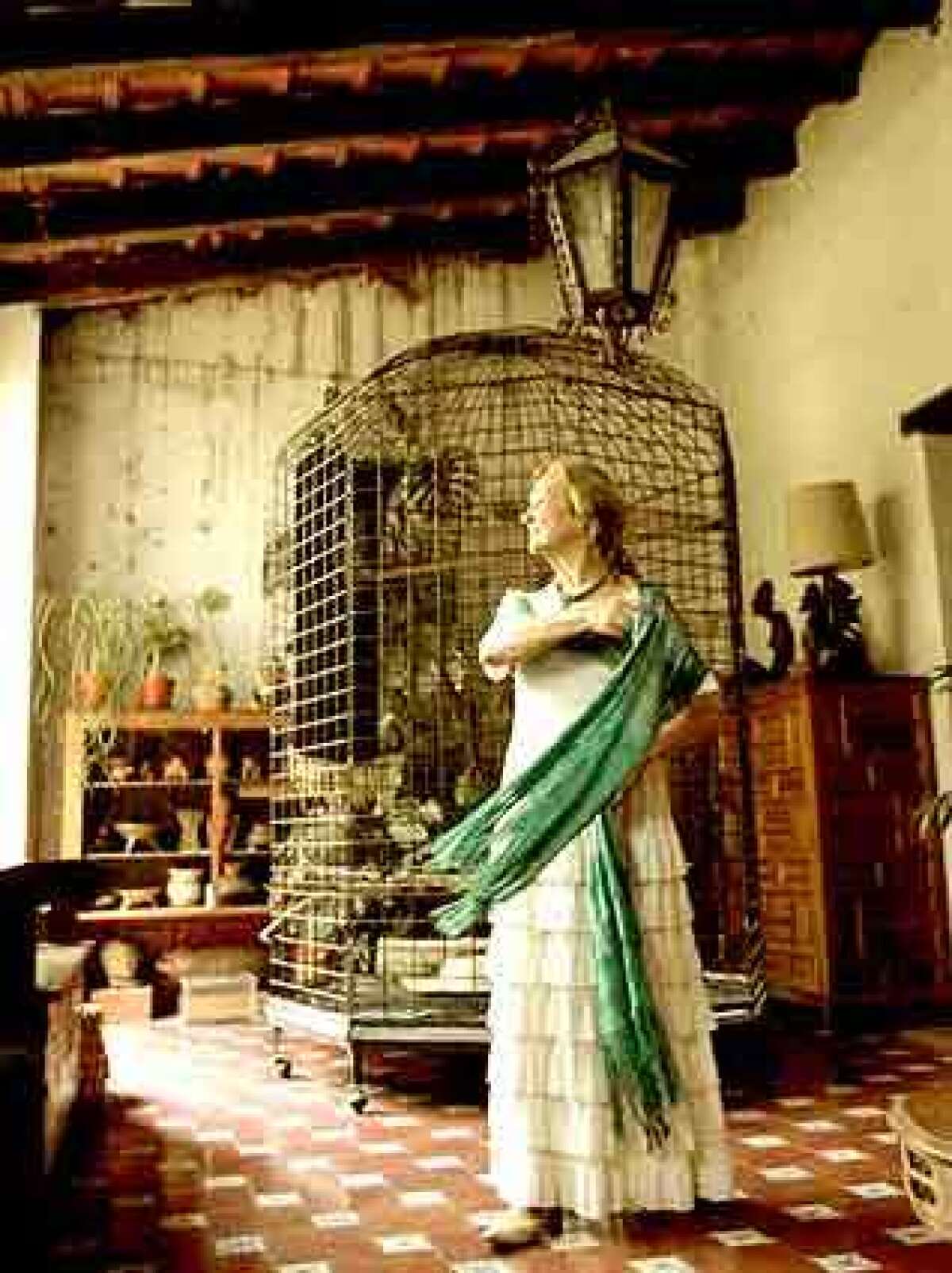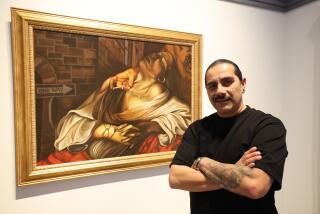House of many spirits

Rising steeply above the narrow sidewalk, the Casa de la Malinche resembles a 16th century fortress, and over the years this hulking edifice has seen its share of invasions and alterations, not all of them friendly. Its oldest sections are believed to date back 500 years. Legend has it that the Spanish conquistador Hernán Cortés used an earlier version of the house as a retreat while he and his soldiers lay waste to the Aztec empire. In one of its several previous lives, the structure served as a municipal jail. Later, it was a monastery.
At another stage, part of its ground floor was chopped up and converted into a pharmacy. “It had many uses throughout all its history,” says Rina Lazo, who has lived in the Casa de la Malinche with her husband and fellow artist Arturo García Bustos for the last four decades.
Even today, the couple say, the old house functions as a kind of impregnable citadel in this noisy, pushy, smog-choked metropolis of 20 million. Strategically situated on the edge of a placid park in the city’s historic Coyoacán district, the Casa de la Malinche is a tranquil and civilized buffer against the slings and arrows of outrageous auto traffic, raucous street vendors and the thousands of day-trippers and tourists who troop through the neighborhood on weekends.
The house has a complex symbolic pedigree. Its namesake, La Malinche, was a Nahuatl-speaking Indian woman who became Cortés’ translator and also shared the conqueror’s bed (“la malinche” is translated as “the captain’s woman”). Because she assisted the Spaniards in their defeat and subjugation of Mexico’s native peoples, she has long been regarded as a national traitor, a femme fatale foil to the beloved national heroine, the Virgin of Guadalupe.
Today, the limestone, brick and adobe house is not only an oasis for its owners, it’s also a bastion of traditional Mexican cultural values, which Lazo and García believe are currently under siege. It’s filled from floor to ceiling with art: pre-Columbian sculpture, antique furniture and a stunning array of paintings, drawings and prints, including works by three of Mexican Modernism’s founding godparents: Diego Rivera, Frida Kahlo and David Alfaro Siqueiros.
For Lazo and García, the connection with this legendary artistic patrimony is both palpable and personal. Lazo spent 10 years working as an assistant to Rivera, whose monumental murals helped define the nation’s post-revolutionary identity and whose iconic bulk looms over 20th century Mexican art like the volcano Popocatépetl on the city’s southeastern fringes.
García was a student and disciple of Kahlo, Rivera’s on-again, off-again spouse. In the years since her death in 1954, Kahlo’s tragedy-scarred life, colorful fashion ensembles and eccentric, introspective art — so different from her husband’s — have turned her into an international feminist martyr and posthumous style diva. They’ve also made her a film star, in the person of actress Salma Hayek, who portrayed Kahlo in the 2002 Miramax release “Frida.”
But let’s not go there just yet.
Oops — too late. As Lazo and García guide a visitor through their art-studded salon, a casual mention of the movie about the first couple of Mexican art sets Lazo off on a spirited monologue. “It’s sad, because it’s a good movie that could have been much better,” she says. Yes, Lazo acknowledges, there were lots of alcohol-fired late-night parties in the old days, but not the libidinous bacchanals that the movie would have you believe. Lazo and García ought to know, having been regular guests at Kahlo’s former home, the Casa Azúl (Blue House), now a museum less than a dozen blocks away in Coyoacán.
The couple also feel that the movie shortchanged Kahlo and Rivera’s ardent commitment to leftist political causes. “And lesbianism, there was none of this,” Lazo insists, contradicting the conventional wisdom about Kahlo’s bisexuality. “This is an absolute invention.” Or rather, she says, this image of Kahlo might have been fostered by her mischievous husband, Rivera, who loved dropping social bombshells, even fabricated ones. “Frida was very enamored, but of men, not of women,” Lazo says with “case closed” finality.
A sprawling, multilayered matrix that fills up a quarter of a city block, the Casa de la Malinche was conceived on a dramatic scale that fits its current owners. The master bedroom, with its jaguar skin-draped bench and raised platform bed, could be a stage set for a production of “Arabian Nights.” The library, packed to the rafters with art books, overlooks a bougainvillea-framed courtyard.
As you reach the landing at the top of the main staircase, you’re greeted by a large, professorial-looking owl named Tecolotzin, after an Aztec ruler. “It has an intelligent face, but who knows if this is true,” García says playfully, eyeing the beast in its enormous cage. “It has not written ‘Don Quixote,’ nor anything of that style.”
The Casa de la Malinche is a showpiece but not a museum. Before Lazo and García purchased it in the early 1960s, the roughly 10,000-square-foot house had endured decades, if not centuries, of slow decline. Upkeep is expensive, and its owners tend to its décor and maintenance with an artist’s practiced eye.
But the house, thankfully, doesn’t have the preening, “ready-for-my-close-up” obsessiveness of so many “designer” homes. You may notice a patch of peeling paint on the ceiling, a clutter of artists’ materials in some corner. Like its owners, the Casa de la Malinche is warm and inviting.
The second-floor salon, where Lazo and García do much of their entertaining, pays homage to their famous mentors, or maestro Rivera and maestra Kahlo, as the couple refer to them. Graced with a high ceiling and natural light flooding through the tall windows, the room is arranged around two sofas and a long wood-and-leather bench. A geometric-pattern rug from Istanbul, a coffee table and an antique book stand add visual accent marks.
But upon entering the room, your eyes instantly drift toward the walls. There’s Lazo’s still life of a mound of coconuts, rendered in Cubist, Cézanne-like fashion. And over there, her portrait of the couple’s only child, Rina García Lazo, an architect who lives downstairs with her two young children.
A few feet away, hovering like an apparition, is Rivera’s life-size portrait of a statuesque woman in a blue dress. Lazo identifies her as a lover of Henry Ford, the autocratic auto magnate whose son Edsel brought Rivera to Michigan in the early 1930s to execute the “Detroit Industry” murals at the Detroit Institute of Arts. Alongside it hangs Kahlo’s drawing titled “The Cup,” from the late 1930s or ‘40s, that shows a vessel fashioned out of the heads of people representing different races or ethnic groups.
Small. Cryptic. Vaguely creepy. Very Frida.
On an adjacent wall there’s an unfinished Rivera drawing that commands attention for its inscription from the master to his then-youthful apprentice: “For Rina Lazo, who helps me to paint and to live.”
“We had the luck of being close to these grand masters, [José Clemente] Orozco, Rivera, Siqueiros and Frida,” says García, among whose own best-known works are the murals in the municipal government palace in the southern state of Oaxaca. “Yes, it was a marvelous epoch,” Lazo chimes in. Often, Lazo says, she wishes that more of her time on earth had overlapped with that remarkable era.
In their younger days, García and Lazo were immersed in the heady mixture of political activism and passionate art-making that swirled around Kahlo, Rivera and their colleagues. The couple met when the maestro ordered Lazo, his assistant, to help García make posters for a political demonstration. “It has united us much, the artistic interest, and politics, and the concerns, everything,” García says.
Indeed, after so many decades of adjusting to each others’ grooves and contours, Lazo and García fit together as snugly as wooden floor joists. A striking woman in a creamy off-white shawl and a cascade of gold jewelry, Lazo, originally from Guatemala, is the more theatrical personality and does much of the talking. Her more circumspect husband, who grew up in Mexico City, listens and speaks carefully, regarding his wife with affection and stepping into the conversation whenever she misplaces a name or forgets a date. Despite their still-fiery political idealism, they manage to keep the world’s troubles in check with gentle, ironic humor.
Central to this marriage, and this creative partnership, is a shared belief in the abiding value of centuries-old artistic methods, a preference for the organic over the engineered, the hand-made over the computer-generated. The couple have little interest in prefabricated art, bland domiciles, soul-less neighborhoods, cookie-cutter lives.
Stepping into the Casa de la Malinche, through a heavy wooden door that opens directly onto a public sidewalk, feels like stepping back into a slower-paced, more contemplative era. Immediately to your left, a stone passageway leads into the couple’s print-making studio, filled with old-fashioned printing equipment. “This technique is rather in disuse,” García concedes, “but it’s marvelous. Rembrandt used it, Goya used it.”
García admits that he’s still learning his way around computer-assisted designing. “I feel very challenged at the base of a keyboard.” As an artist, he says, he finds it easier to express his sentiments and emotions when modeling with clay. His wife agrees, lamenting the gradual loss of traditional brush-painting skills. “It’s going to disappear, the painting made by hand, with the heart,” Lazo says. “I already say there’s not going to be a Frida Kahlo in the future.”
But devotion to time-tested methods and beliefs needn’t mean living in the past. From scattered stacks of drawings, prints, fresco paintings and watercolors, García pulls out one of his latest works, a small black-and-white image of a despondent-looking man sitting on the edge of a great city. Behind him loom two high-rise towers and a black jet.
“The 11th of September,” García says, “and an artist very preoccupied for the world, for the future of the world.”
Sometimes the artist tries to embrace the world and comfort it. Other times, he or she must hold it at arm’s length, or else go mad, as Lazo and García can attest.
In Coyoacán, as in other historic Mexico City neighborhoods, a battle is underway to preserve the unique and irreplaceable qualities that make the area so attractive, not only to residents but to outsiders. Along with many of their neighbors, Lazo and García have been fighting a proposed 900-seat open-air theater that would be located in the small, charming park directly across from their house.
Though its sponsors have said the theater would be used for classical music concerts and such, the couple suspect it would open the door to more aggressive entertainments. The park, they believe, should be a site for strolling, meeting friends and thoughtful repose, not, in Lazo’s words, a place where “one comes to divert oneself and dance cumbia.”
Gradually, the couple fear, more and more of their neighborhood’s genteel character is being chewed up by commercial traffic and entrepreneurs who know a lucrative trend when they smell it. In recent years, several of the couple’s friends have fled Coyoacán in search of quieter pastures.
“Here, the neighbors, we want to conserve this place, as it should be, as a historic center, for its history, for its monuments,” Lazo says. She and her husband are grateful that the old foundation walls of the Casa de la Malinche are some 3 feet thick. “Look at the width of the wall!” Lazo says, brushing her hand along its grainy mass. “This helps us to protect ourselves from hearing the street, the noise of the cars.”
The couple believe that the thickest walls in the house correspond to those of the original one-story structure where Cortés and La Malinche lived for a year, probably around 1521 or 1522. According to García, Cortés chose to put himself up in Coyoacán because the great Aztec capital of Tenochtitlán (present-day downtown Mexico City), after being sacked by the Spaniards, was full of rotting corpses.
In the centuries that followed, the house assumed other guises, including its monastery phase. Then in the 1860s, the liberal president Benito Juárez implemented his famous land reforms, and the monastery and its grounds came into the hands of a peasant family that had made tortillas for the monks. Lazo says that part of the grounds was still being used to till corn when she and her husband moved in 40 years ago.
In the 1930s, the house caught the attention of José Vasconcelos, the formidable Mexican education minister who commissioned Rivera, Siqueiros and other artists to paint the great public works murals that would articulate a vision of Mexican identity after the revolutionary upheaval of 1910-20.
Aware of the Casa de la Malinche’s historic value, Vasconcelos bought the house. Though he never lived there, Lazo says, Vasconcelos reconstructed its roofs and restored or replaced its collapsed beams.
Eventually the house passed to Vasconcelos’ daughter, Doña Carmen Vasconcelos. Around that time, in the early 1960s, Lazo and García were living in an apartment and searching for a larger space with room to accommodate an art studio and their newborn daughter. They persuaded Doña Carmen to rent them the house, which was later put up for sale. The couple saw their opportunity.
“No one wanted the house, because it was ‘an old house,’ and it was of the era in which everyone was casting aside their old houses and going toward a modern one,” Lazo says.
She and García had just received payment for some murals they’d painted for the city’s dazzling new Anthropology Museum. By pooling their money they were able to buy the house. “The fact is that it pleased Doña Carmen very much,” Lazo says. “She said, ‘Hey, no Mexican wanted to buy this house from me, it was always foreigners, and I didn’t want to sell it to any foreigners.’ That’s why it pleased her, and why she sold it to us.”
Reconstructing the house, and trying to restore it to something approximating its original design, was a 10-year project for the couple. Gradually they’ve managed to reconfigure many of the rooms and to find antique doors, windows and metal grillwork sections to replace missing ones. They have unearthed sealed-up windows in the kitchen and excavated ancient, hidden partition walls. Today, the Casa de la Malinche enjoys protected status as a registered colonial monument, and “not a single change can be made” without official approval, Lazo says.
Dusk is stealing on, and a bottle of fine tequila and some savory Oaxacan cheese are produced. Outside the house, rush hour is underway. But barely a sound penetrates the stout stone walls as the couple regale their guest with more stories and opinions on art, politics, everything.
Yes, Lazo and García agree, Mexico’s political and economic future is uncertain. Yes, immigration and globalization are raising troubling questions throughout the hemisphere.
And yes, the couple say, they plan to stay in their neighborhood and keep fighting, for Mexico and for Coyoacán. In Rivera and Kahlo’s heyday, García says, Mexicans were filled with “a great passion” to rebuild their society. Now, he believes, the country faces a comparable challenge.
“We were moved with the idea of the construction of a new world,” he says of the old days. “It was delayed. But it has to return to sprout again, although many years later, and it must take new forms.”
Just as the Casa de la Malinche has done.
More to Read
Sign up for our L.A. Times Plants newsletter
At the start of each month, get a roundup of upcoming plant-related activities and events in Southern California, along with links to tips and articles you may have missed.
You may occasionally receive promotional content from the Los Angeles Times.







